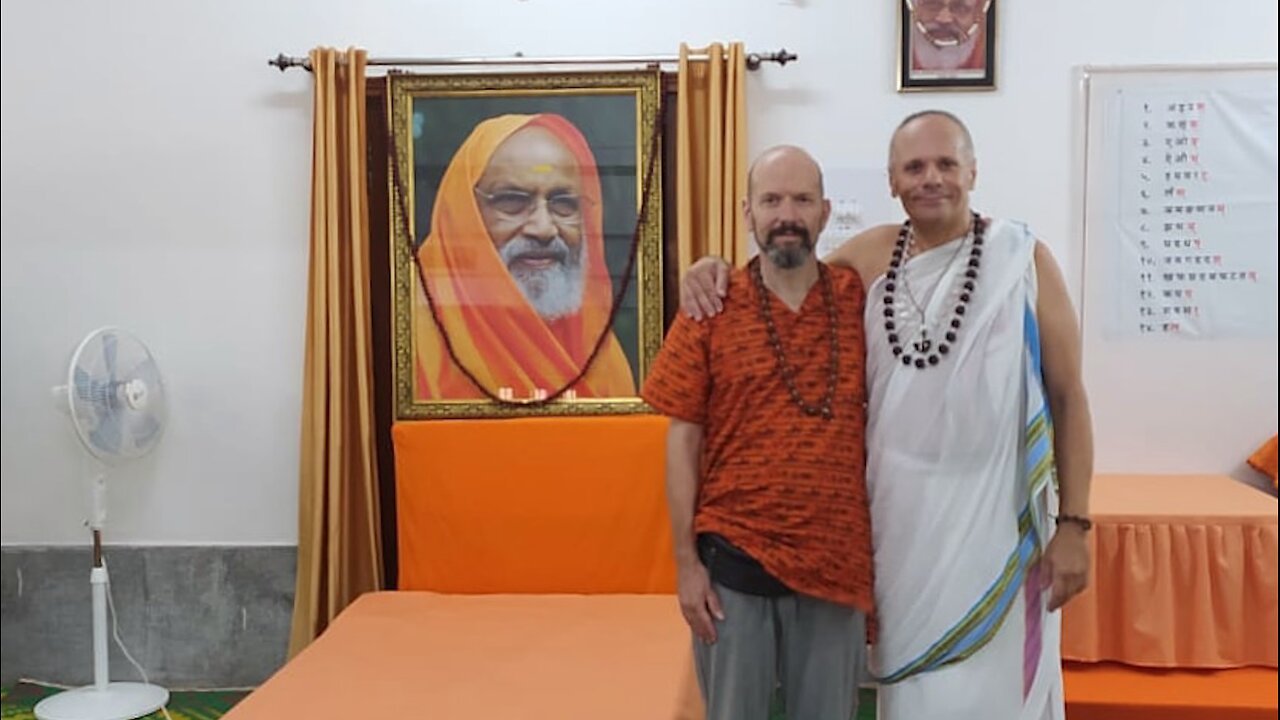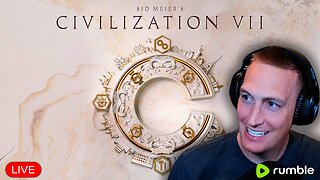Premium Only Content

ESTABLISHED IN BRAHMAN #1 - Discussions on Advaita with Sacchidananda Acharya & student Subodhananda
FULL TRANSCRIPT
ESTABLISHED IN BRAHMAN #1 -
Spontaneous discussions on Advaita Vedanta with Sacchidananda Acharya and his student, Andrew
ANDREW
I was watching Ramana Maharishi’s documentary yesterday.
SACCHIDANANDA ACHARYA
I’ve seen that many years before. It is amazing.
ANDREW
Yeah. For me anyway, it’s worth watching many times.
SACCHIDANANDA ACHARYA
Yeah, sure. It is.
ANDREW
There’s an interesting dialogue – well, many interesting dialogues. But, there’s one interesting dialogue with one of his principal disciples. Whose name I can’t remember, it’s like Ganapati or something like that; a famous disciple of his. And, he asks, the disciple asks, ‘What is tapas?’ And I personally, don’t know what it means.
SACCHIDANANDA ACHARYA
Tapas means, spiritual practice, sadhana. Another name for spiritual asceticism.
ANDREW
Ah OK. Because this guy’s, like a, phenomenal scholar and everyone is impressed by his presence even. You know, he’s like, people were in awe of him, this disciple. And he went to Ramana Maharishi and he said, ‘I know everything, about everything, but, please, I need help. Please, tell me what is tapas’.
And then the answer, it’s something like, basically, ‘Go looking for the ‘I’, and look for the source of the ‘I’, and when you find the source of the ‘I’, the ‘I’ will dissolve into the source and then the Real ‘I’ will appear’. Something very close to this that he said.
So, what’s the difference between that – looking for the source of the ‘I’ – and the practice that you tell me to do, which is [to ask], ‘What is looking at the ‘I’? Or, when you’re meditating on emptiness for example, and there is no 'I', what is able to accommodate that experience? Are they the same practices, just in different words?
SACCHIDANANDA ACHARYA
Yeah, it is the same practice, as an end result, but from another standpoint. So, you can go to the top of the mountain through different paths. So, there are many kinds of practices, tapas, or sadhanas that will reveal that the fake, small ‘I’, does not really exist. It is only what we call in Advaita Vedanta, chidabhasa, which means, the reflected consciousness.
So, by trying to find it, by trying to see whether this small ‘I’ does really exist or not, it runs away, it disappears by itself, because it is like a ghost. It does not have inherent existence - it borrows its existence from the real Consciousness, the real ‘I’.
This is also what they are referring to when they speak about Atma Vichara in the writings of Ramana Maharishi, but when Ramana Maharishi was speaking about doing Atma Vichara, he was not, of course meaning, or wanting to say, to ask ‘Who am I?, Who am I?, Who am I?’, like a parrot.
Atma Vichara, it does really exist in Advaita Vedanta Guru Parampara, or Holy Tradition, and it is Sravanam and Mananam. Listening and enquiring into the nature of Atma or Brahman, this is Atma Vichara. Atma Vichara really means investigation or enquiry into the nature of Atma or Brahman, which cannot be done by simply asking the question, ‘Who am I? Who am I?, Who am I? Because actually, there is no answer to this question.
Atma Vichara cannot be revealed and cannot be done through this question. It can be revealed only through Mahavakya Upadesha, through a qualified Guru, who belongs to a Guru Parampara; Sampradaya. And through his guidance, you do what we say are, Sravanam, Mananam and then Nidhi Dhyasanam to internalize all this total enquiry.
ANDREW
So, what was the Sravanam and Mananam that Maharishi’s disciples did then? It was this analysis…
SACCHIDANANDA ACHARYA
They were not actually doing in the right way Sravanam and Mananam and also Nidhi Dhyasanam, because he himself Ramana Maharishi was not part of any Guru Parampara – at least in this reincarnation, in his last reincarnation – so he was not able to guide his disciples according to the Upanishads.
He was trying to guide them according to his personal experience and through his realisation, but that is not enough. It can only be enough to those who are on the same level of spiritual maturity as himself. Because if you say to anybody, just ask, “Who am I?, Who am I?, Who am I?, nobody will be able to find out the truth and to find out the nature of the Self. It is impossible.
It needs only Sravanam, Mananam and Nidhi Dhyasanam and a constant and regular study under the guidance of a competent Guru – there is no other way. Unless, of course, it is mentioned otherwise in the Upanishads, but that is not the case.
ANDREW
Yes, because, some of his disciples then must have been very close to attaining realisations before they met him…because…
SACCHIDANANDA ACHARYA
Yes, they were.
ANDREW
…they attained realisations some of them, just by…
SACCHIDANANDA ACHARYA
Yes, they were.
ANDREW
…just by listening to a few instructions, because he did teach a little bit. They just listened to a few instructions and some of them they attained realisations just by being in silence with him. So, they must have been very mature.
SACCHIDANANDA ACHARYA
Yes, exactly. Some of them, they were really ready for such a kind of teaching, just like Ramana Maharishi himself was ready at the age of sixteen years old. He had this death experience and it was enough to complete his Self-Realisation process.
And also the one who wrote one of his first talks. He was also a very well-known scholar and a well-known person in India and he was known for his realisation. And also, all those who were around him in his Ashram, they were really very advanced.
ANDREW
So, when we talk about Sravanam, Mananam and Nidhi Dhyasanam, it’s for the vast majority of people, they need a very systematic [approach]. It’s only a few exceptions, where you can condense this.
SACCHIDANANDA ACHARYA
Yes, exactly. It’s like, Ramana Maharishi himself, of course he was not in need of doing this process of Sravanam, Mananam and Nidhi Dhyasanam, in this reincarnation, in his last reincarnation, but how many are on that level of spiritual maturity?
ANDREW
I wanted to ask you something about flexibility and adaptability and spontaneity because yesterday, for example, I was watching that [Ramana Maharishi] documentary, I listened intently to this dialogue when Ramana Maharishi said, ‘Search for the source of the ‘I’.’
I was very inspired to follow that instruction, and I think it was the right thing to do. I didn't do it, though. I think it was the right thing to do, to follow that instruction because I was inspired in that moment, to do it right there, you know.
But because you'd given me a slightly different instruction, I thought, my mind, was like no, no you can't [laughs] you can't follow this inspirational moment. You must stick to what you've been told.
I think my mind is like a dictator sometimes, like a dogmatic dictator because it would have been [OK] – it's the same question just from a different standpoint as you explained earlier. And why not go with the inspiration in the moment?
SACCHIDANANDA ACHARYA
Yes, you can use different approaches to gain the same end result, looking straight away, at the nature of awareness - which is the only real Self and the only reality. And it depends also from the sadhanas or tapas, that each and every individual did in his or her past lifetimes.
So, if for example, somebody is used to sadhanas or tapas according to the Dzogchen tradition, then he will feel more familiarity with such kind of practices or meditations or teachings, and this will work much more than, for example, of those of Advaita Vedanta path, let’s say.
So, it depends always what happened before - what kind of spiritual practices and spiritual habits each and every individual had. Of course apparent individual because there are no individuals in reality.
So, for Andrew, for example, practices and sadhanas or tapas which are connected mostly with the Buddhistic approach, may be more helpful let's say, or more familiar and they will not need so much practice because of practicing before in previous lifetimes.
And similarly for another one, who did a lot of practices and was working in Advaita Vedanta path, in this lifetime will seem much more familiar and it will be more beneficial to him or her. That's why there is no problem to be different paths, because it is according to each and every apparent individual what he or she really needs.
ANDREW
Also, in the moment, when you're inspired it's okay to follow your inspiration in that moment. Like, the example I gave, I was inspired to follow Ramana Maharishi’s instructions in that moment.
SACCHIDANANDA ACHARYA
Yes, also it is about how you feel in the particular moment and how you are open or not, and, if this can be inspiring, this moment, then yes, you can follow it and you can try it, and there is no problem. Whatever is helpful you can use it. You can go according to the circumstances and how you feel.
But on the other hand it is always more helpful to follow the guidance that you can find in the ancient scriptures, in all the legitimate and real Sampradayas, Guru Paramparas, which is a more, let's say, secure environment, instead of experimenting all the time.
You can also experiment and see how you feel and how you can be inspired, but also you have to follow the previous paths and the previous stages who have walked the path and who can really offer very, very precious instructions.
ANDREW
Yes, it's not something, I mean, to do all the time. I’m just like in…
SACCHIDANANDA ACHARYA
Yes
ANDREW
…that one moment.
SACCHIDANANDA ACHARYA
Yes
ANDREW
It is not something to be done regularly – experimenting, I mean.
Similarly, this is a slightly different question again because in this instance I have no instructions. So, when I'm reciting the Mantra that I was given, I'm experimenting a little when I'm reciting it.
For example, maybe this is me being stupid, I don't know, but I'm reciting the Mantra and I do it differently nearly every time, in a sense - not major differences because I'm just reciting a Mantra, how different can it be.
But I'm reciting the Mantra and…For example, I think it was the day before yesterday, and when I'm reciting it, I'm really trying to get [I'm reciting it inwardly not outwardly, inwardly] - and it's like, I'm trying to become one with the Mantra.
And when I'm reciting it, it's almost like the inner vibration, I want to pervade my entire being. That's just me making up an idea, I mean, I have no idea. I've not had any instructions exactly how to recite the Mantra inwardly.
But to become one with a Mantra so it pervades my inner being. So I'm experimenting, and it was inspiring to do it like that. To really get inside it and to become one with it, and to feel like it was vibrating inside my inner being.
So, this kind of experimentation I presume is okay because, why not?
SACCHIDANANDA ACHARYA
Yes of course no problem. No problem. But, always you should remember the instructions of the Guru Parampara, that it's not about the experience that is the most important. For example, a lot of people they are searching blissful experiences - you know that - which by itself is not bad, but when it becomes, how to say, when it becomes a wish and a strong desire to do spiritual practices only to have blissful experiences or exotic experiences then it can become an obstacle.
Because whatever is an experience is something impermanent and something which is connected with the mind, so it cannot lead you to the truth and to the recognition and conviction of what you really are.
So, the instructions, for example, from the scriptures and especially the Upanishads, are not to be overly interested about having experiences while you do your sadhana, your spiritual practices because this may lead you astray.
Yes, if they come, you accept them. But you should not wish for them, you should not get stuck on them and you should use them as only a stepping stone and go beyond, any kind of experiences.
So, all the beautiful experiences are the result of having the mind in a restful state and bringing out the true nature of the mind, which is connected with the source, the real Consciousness itself. But to search for beautiful experiences or blissful experiences by itself can be an obstacle.
ANDREW
Yeah, so it's ego driven.
SACCHIDANANDA ACHARYA
Yeah, the ego will try to use these beautiful experiences to go astray and to use them as entertainment. When in reality we don't do spiritual practices for any kind of entertainment or blissful experiences. We do spiritual practices to know the Self, to know which is our True Nature our True Self, what we really are; Self-knowledge.
If they come some nice experiences okay, you accept them, and you welcome them, but not to get stuck on them and not to wish for them.
ANDREW
Yesterday for example, when I was reciting my Mantra, it’s before I do my meditation. So really, the more profoundly that I merge, if you like, into the Mantra, the more blessings I receive, the better my meditation. So, it's a preparation I'm doing for my meditation, it's not an end in itself.
SACCHIDANANDA ACHARYA
Then it is okay, especially the recitation of the Mantra that Andrew has received, by doing japa mala, it is not for Self-knowledge. It is not for revealing the nature of the Self or what you really are. It is for chitta suddhi, the purification of the mind, the preparation of the mind. So, by itself it is a preparatory practice anyway.
The same with upasana, any kind of meditation on deities or forms of God, Saguna Brahman: all these are just preparatory practices and you can gain with them purification of the mind, preparation of the mind, in order sequentially after to be ready for Jnana Yoga, Self-knowledge, which is the highest form of Bhakti.
SACCHIDANANDA ACHARYA
So, Bhakti is really threefold. It’s Karma Yoga, Upasana and Jnana Yoga. Unfortunately, nowadays they present these forms in a wrong way. They say Bhakti Yoga is for emotional people and you can gain Self-realization, Moksha even with only Bhakti Yoga; with worshipping of any kind and pujas and rituals.
And they say with Raja Yoga you can also enter to moksha, doing different kinds of meditation - which is also not correct.
And also they say, that if you are active an active person, that you can enter to Moksha through activities for the benefit of humanity and so on and so forth, but all this is completely against the Scriptures. You cannot have Self-knowledge with Karma Yoga, or with pujas or with worshipping of any kind, or with any kind of meditation.
Meditation by itself cannot reveal The Self, cannot reveal our True Nature, it is only for
preparatory purposes and for the purification of the mind, but it cannot by itself reveal what you really are; Self-knowledge.
So, real Bhakti according to the Upanishads, which is of course the highest form and the most profound teachings that ever existed, is a combination. Bhakti Yoga is really a combination of Karma Yoga, Upasana and Jnana Yoga.
ANDREW
So, when you say, ‘according to the Scriptures’, it's important to understand, isn't it, when you say Scriptures, it means the realization of the Rishis and the Saints of the past. It's not some book [laughs]. It’s not some dogmatic book, it's the realisations of the highest level.
SACCHIDANANDA ACHARYA
Yes, and the Rishis, always they mention, that this truth that they have conveyed, it's not their own truth. It is what they have received from their Gurus and their Gurus have received from their Gurus and their Gurus have received from their Gurus and so on and so forth.
So, the actual source of these teachings are not the Rishis themselves, it is the Ultimate Consciousness. It is what we call Isvara, or Bhagavan, or God - the Saguna aspect of Brahman, which is the controller of the apparent universe and the apparent beings.
The ultimate Guru or the Adi Guru as it is mentioned, it is Isvara himself, God himself, Saguna Brahman. God, who is at the same time the controller, together with Maya.
ANDREW
I was reading about Maya, and at the end of this amazing book that I've been reading – Thoughts From the Gita - it's very, very good. It's a very profound book, very intellectual and a lot of it I need to read many times, probably.
And everything in it as far as I'm aware, as far as I’m aware – which is not that far - is correct and in accordance with the lineage - that's why they sell it at Sringeri, and when it got to what is Maya…it really, I don't understand it. Really.
I’m reading a little bit and thinking okay, I understand English, but really, it's like ‘the potential for all experience’…he gives different short explanations [of Maya] and he gives a long definition - but I really don't understand it.
What can you tell me about Maya, or is it important to even know about it?
SACCHIDANANDA ACHARYA
Yes, Maya is the most difficult topic in the Upanishads because it cannot fall into the category of existence, or into the category of non-existence. So, it is the most, most profound and the most difficult issue because Maya is something like the shadow of Brahman and through Maya whatever appears and disappears can be so.
Because Brahman cannot create and cannot do anything. He is only the substratum. This substratum, this Source cannot produce and cannot create and cannot do anything at all. But Maya it's a kind of shadow, it's a kind of a power of projecting the apparent universe and the
apparent beings.
But in itself, Maya you cannot say that it really exists, or it does not exist. It is - as the Upanishads mention - seemingly existent, the same as the universe and the apparent beings. They are not really created, it is only an appearance through the projecting power of Maya.
So, just like the dream, you cannot say that the dream does not exist and you cannot say that the dream really does exist. For the dreamer, whatever appears in the dream, it is fully functional and fully appears as real for the dreamer.
The same with the apparent universe and the apparent beings. Just like in the big dream everything experientially appears real, the same with the dream in the night. For the dreamer, experientially, everything appears real.
So, there is experienceability for the dreamer, in the dream in the night. There is utility.
If the dreamer is thirsty and somebody offers him water, the thirst will go away. And also
there is transactability. The dreamer can have transactions with other apparent beings, just like it is real.
But upon waking up, there is not any more this dream world. So that's why in Advaita Vedanta we use the dream, because you have an experience of something, but it doesn't prove it's real existence. That's why I said earlier that any kind of experiences in sadhanas, in spiritual practices does not really mean so much.
It's not about experiencing, in spiritual practices. It is about internalising the truth that you have been receiving through Shravanam and Mananam. That's why in Advaita Vedanta we don't start with Nidhi Dhyasanam, we start with Shravanam and Mananam and then we internalise, or assimilate this truth with Nidhi Dhyasanam.
But in other spiritual paths, they start somehow with meditation, which is wrong, because experiences are on the level of the mind. Anything that is an experience, actually it is impermanent. It is not something stable. It comes, it goes. It comes, it goes.
But what is accommodating each and every experience does not come and go. The substratum of Awareness / Consciousness / Brahman, does not come and go. It's always the same. It is always unchanging. It is this formless, nameless, birthless substratum. It is like a space-like field, which is always unchanging.
Just like the screen of the cinema, whether there is an experience of a drama on the screen or an experience of a comedy, the screen itself does not change. It can accommodate both experiences. It can accommodate a good, a positive or a happy event on the screen or it can accommodate a dramatic event. But, by itself, the screen does not have any kind of a change.
It is exactly the same with our True Nature as Awareness, Consciousness. So, it is not important to have beautiful, blissful or exotic experiences. They cannot reveal Awareness itself. They may give some kind of courage, you may feel that it was nice and you may enjoy these experiences, but by themselves they cannot reveal what you really are.
So, to be so much concerned about having spiritual experiences, it is not the true way of finding your True Nature, your True Self.
ANDREW
So, you said it (the substratum of Awareness) is like a space-like field.
SACCHIDANANDA ACHARYA
Yes, which does not have a beginning or an ending point. It does not have any borders.
ANDREW
So, if you are in Nidhi Dhyasanam and you're experiencing…any experience you have in Nidhi Dhyasanam, like for example, your mind might become very peaceful and feel vast and space-like, is still something that you're observing.
Can you experience…strange question…but can you experience your true nature? Can you experience your Self? Is it an experience?
SACCHIDANANDA ACHARYA
No, it cannot be an experience…
ANDREW
- But what can it be then? –
SACCHIDANANDA ACHARYA
…because that would mean that you objectify your True Self. But your True Self – Awareness – cannot be objectified. It is the subject. It is the Seer. It cannot be the seen. It cannot be an object that you have an experience of.
It is that which can accommodate each and every experience, but by itself cannot be an experience.
It is like you want to see your eyes - the eyes to see the eyes. That is not possible. The eyes cannot see themselves - except of course if you use a mirror. The same with Awareness. Awareness cannot see itself as an object because it is the only one that really exists – it cannot be an object of observation.
So, by trying to see yourself, or to know yourself, or to experience yourself - it is impossible. Experience cannot help. Any kind of an experience is an impermanent thing, a mithya thing - something that appears and disappears and something which is not permanent; mithya.
So, what we do in Advaita Vedanta, we receive the revelation of the Upanishads. We receive through Shravanam and Mananam this revelation, and then we internalize, assimilating through Nidhi Dhyasanam, through the Vedantic meditation process, which is not a meditation as we know from other paths, which is a kind of an absorption, or silence. Nidhi Dhyasanam, Vedantic meditation is more a contemplative method.
It's like you are refreshing and you are seeing or internalising again and again all the Teaching that you have received previously from Sravanam and Mananam. And now you want to marinate yourself in this truth. And you contemplate this truth – you don't want to go into a kind of absorption in silence until you have a permanent and total recognition and conviction of what you are: That.
Silence may help as a preparation, or after you have seen the truth – on a contemplative basis – silence can help after just to enjoy, and to dwell in it as That. But by itself silence, or the negation of the mind, or silencing the mind, does not really help. So, we want the mind. We use the mind. We don't want to “kill” the mind. Anyway, the mind does not really exist as an entity. it is only a tool.
ANDREW
I really can't get that what you're talking about – I really don't get it. For me, silence is essential. It's essential.
SACCHIDANANDA ACHARYA
It is essential as a preparation. It is essential after to enjoy the truth, but it cannot be used as a basic tool for having a profound understanding of what you really are.
ANDREW
Ah OK. I understand that you need to contemplate.
SACCHIDANANDA ACHARYA
Yes, it is not enough. Silence, is not enough.
ANDREW
Okay, okay, so, you need to contemplate, but also that contemplation can be done as a kind of
knowing - there doesn't need to be big thoughts going on. Do you know what I mean? This happened to me the other day. I'm meditating, I'm contemplating, because you have to contemplate if you're meditating on emptiness for example.
You need to contemplate at some point because otherwise you've got no direction. If you're just sitting in silence you're not meditating on emptiness. You need to contemplate the
teachings on emptiness and then that directs you towards “the goal” in inverted commas, but you need to contemplate. But that contemplation sometimes can be almost like silence. As you are looking at the absence of the self for example…
SACCHIDANANDA ACHARYA
You mean the absence of the small or fake self - the body-mind complex.
ANDREW
Yes, looking at the absence of the person, the so-called person – to whatever degree you can do that. When you're looking, (after you've contemplated) and you think, oh my goodness, there's nothing there, there is no person. You can you can look with a knowingness that is silent.
It's like you're seeing or you're knowing – it doesn't have to be with big thoughts – it can be like a silent understanding of what you are doing.
SACCHIDANANDA ACHARYA
Yes, that is okay, but you cannot easily be in that state from the first moment. So, you need the contemplative basis in order to perhaps to enter that state of silent knowing afterwards. Then it is okay. Then you don't need any more what we call the mind, you can just remain and you can just abide in that knowing in a silent manner.
That is wonderful, but that is not easily attainable, especially for junior seekers. For a senior meditator it can be more easily done, but for a junior meditator or a junior spiritual seeker, this abiding in a knowing which is silent it is very, very difficult.
And the same within a Jnani. A Jnani also does not need to do Nidhi Dhyasanam anymore. Sacchidananda doesn’t need to do any kind of Nidhi Dhyasanam, or any kind of meditation anymore, because this knowing is permeating 24/7. So, why to do any kind of Nidhi Dhyasanam or meditation or contemplation? There is no need anymore.
If for more than 12 years there is a permanent recognition and conviction of this knowing, then there is no need. It is just an abiding afterwards, in that knowing. Even if there is no silence, the knowing is there as a permanent recognition and conviction, whether you walk, you eat, you speak – you do whatever the body-mind complex needs to do as an activity – this knowing is always there.
So, to be aware that you are awareness, and that to on a permanent basis, as a permanent knowing and conviction, this is what we call Self-realization, and then there is no need of any spiritual practice anymore.
You may do apparently some participation in Vedic rituals or pujas, or participate in different kinds of religious, or spiritual activities. Not because you need to do the purification of the mind (chitta sudhi),or you need to enter into this knowing, but you may perhaps do this as an example for the other seekers, as a good example.
Or, you may do Vedic rituals for the purification of humanity, just like the Shankaracharyas in the Maths. They are doing for hours. They don't do these rituals for themselves, to become a Jnani – they are already Jnanis. They do these rituals for humanity. They don't really gain anything from these rituals. And they don't need to gain anything from these rituals. Their life is just for service to humanity – loka sangraham, purification and upliftment of humanity. The same with Ramana Maharishi, he did not need to do any kind of spiritual practice.
https://www.advaitaashrameurope.com/
*
-
 LIVE
LIVE
Vigilant News Network
9 hours agoUK Government BUSTED in Secret Plot to Extract Your Data | Media Blackout
1,303 watching -
 1:03:32
1:03:32
Winston Marshall
3 days ago"War On Children!" The DEMISE Of The West Starts With Schools - Katharine Birbalsingh
96.7K62 -
 48:02
48:02
Survive History
12 hours ago $3.43 earnedCould You Survive as a Sharpshooter in the Napoleonic Wars?
43.7K3 -
 12:03
12:03
Space Ice
12 hours agoSteven Seagal's China Salesman - Mike Tyson Knocks Him Out - Worst Movie Ever
31.4K15 -
 11:37
11:37
Degenerate Jay
12 hours ago $4.91 earnedJames Bond Needs Quality Over Quantity From Amazon
51.4K3 -
 15:23
15:23
Misha Petrov
12 hours agoTrad Wives & Girl Bosses Go to WAR!
46.1K42 -
 2:03:11
2:03:11
TheDozenPodcast
10 hours agoFootball villain fighting the state: Joey Barton
39K1 -
 LIVE
LIVE
Scottish Viking Gaming
13 hours ago💚Rumble :|: Sunday Funday :|: Smash the Blerps and Vape the Terpes
347 watching -
 1:45:00
1:45:00
RG_GerkClan
15 hours ago🔴LIVE Sunday Special - It's Time for World Domination - Civilization VII - Gerk Clan
78.9K27 -
 LIVE
LIVE
Major League Fishing
4 days agoLIVE Tackle Warehouse Invitationals, Stop 1, Day 3
135 watching